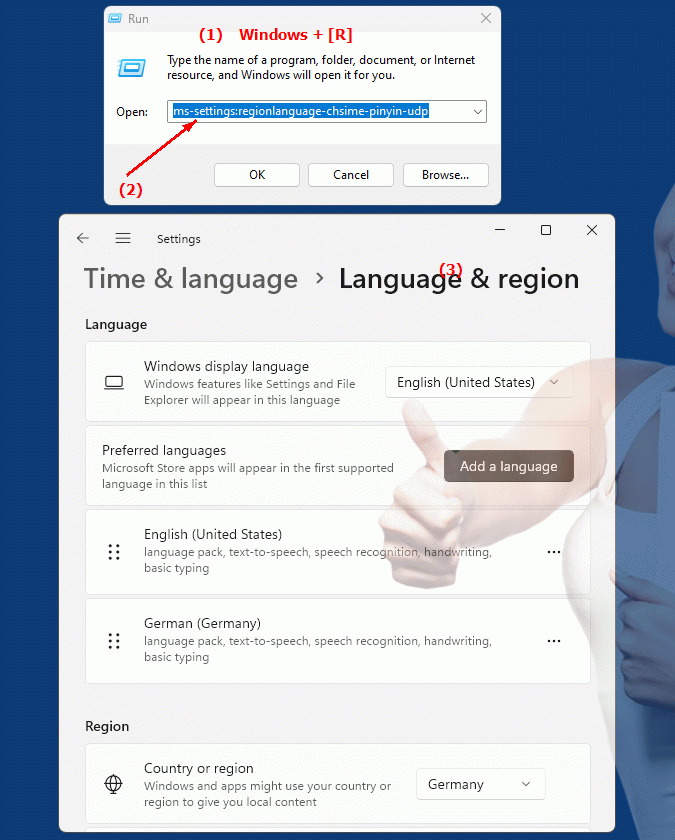The URL and protocol URL "ms-settings:regionlanguage-chsime-pinyin-udp" opens the advanced settings for the Pinyin input method for Simplified Chinese in Windows 10 und 11 .
This feature allows users to make specific customizations and configurations for inputting Pinyin characters in Simplified Chinese, including options for the input methods and their behavior. Here is a detailed description of the availability of this feature in different Windows versions, along with the corresponding build numbers:
1. ms-settings:regionlanguage-chsime-pinyin-udp
2. Availability under Windows
3. Other useful commands in the Windows settings
1. The Command ms-settings:regionlanguage-chsime-pinyin-udp
1. Activate the Run menu by pressing Windows R.2. Simply enter the command: ms-settings:regionlanguage-chsime-pinyin-udp
(Use the command for a desktop shortcut as well.)
3. Press [Enter] or the OK button to execute the action.
(... see Image-1 Point 1 to 3)
The settings described above are now accessible in your Windows 10, 11 or 12 operating system.
This can answer the following challenges and questions.

1b. This can answer the following challenges and questions.
What steps do I need to follow to change the Pinyin input settings in my Windows system settings?Can you tell me how to access the advanced settings for pinyin input in simplified Chinese in Windows?
What do I need to do to enable specific customizations and configurations for Pinyin input in Windows Input Method?
How can I make sure I have all the options to control pinyin input when I open advanced settings?
Is there an easy way to configure Simplified Chinese Pinyin keyboard settings on my Windows computer?
2. Availability in Windows 10, 11 and 12 and the corresponding build numbers.
Windows10
- Availability:
Enhanced Pinyin input method settings were introduced in Windows 10 version 1809 (October 2018 Update). This version improved support for various input methods and enabled more detailed customization of Pinyin input for Simplified Chinese.
- Build number:
The "ms-settings:regionlanguage-chsime-pinyin-udp" URL is available starting with Windows 10 version 1809 (build 17763). Starting with this build, users can navigate directly to the Advanced Pinyin input method settings and configure specific options for Simplified Chinese input, including customizing the input method and input behaviors.
Windows11
- Availability:
In Windows 11, the ability to configure pinyin input methods remains intact and has been updated in the UI to match the new Windows 11 design guidelines. Windows 11 continues to provide detailed options for customizing pinyin input for Simplified Chinese.
- Build number:
The URL "ms-settings:regionlanguage-chsime-pinyin-udp" is available in Windows 11 starting with version 21H2 (Initial Release). This version was released on October 5, 2021. In this version, users can access the advanced Pinyin input method settings and customize the input method according to their needs.
Windows12
- Availability:
In Windows 12, the ability to configure pinyin input methods is expected to continue to be supported, with possible additional improvements or new features tailored to the latest versions of the operating system. Windows 12 will likely offer more evolved options for customizing pinyin input.
- Build number:
The exact build number for the feature's introduction in Windows 12 will be provided after the first versions of the operating system are released. However, the feature is expected to be available starting from the early builds of Windows 12 and include the latest options for configuring the Pinyin input method.
Summary
The "ms-settings:regionlanguage-chsime-pinyin-udp" URL is available in Windows 10 starting with version 1809 (build 17763) and remains available in Windows 11 starting with version 21H2, as well as in Windows 12. This URL allows users to directly access the advanced settings of Simplified Chinese Pinyin input methods to make specific options and customizations. The exact build number for Windows 12 will be provided after the initial releases, but the feature is expected to be included in the early versions of the new operating system.
